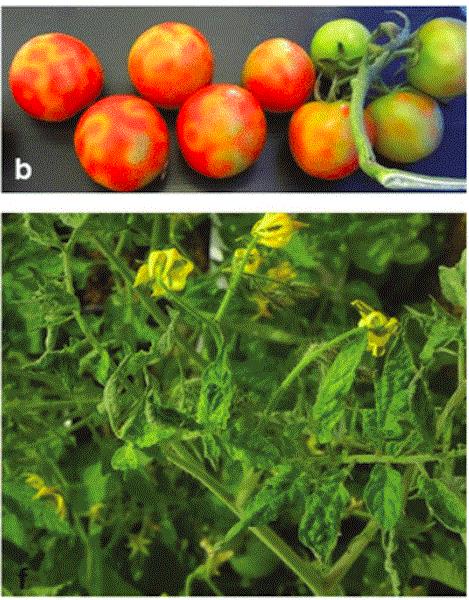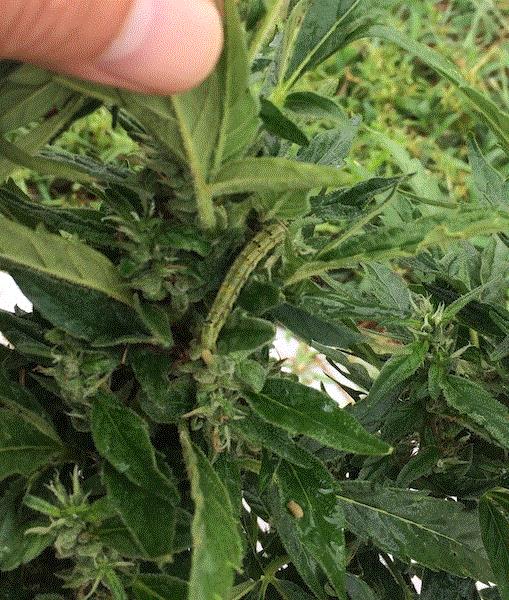APHIS vs. tomato virus
Here’s a critter y’all may not have heard of — tomato brown rugose fruit virus (ToBRFV). But, if your livelihood depends on growing tomatoes and peppers, either indoor or outdoor, you know what I’m talking about.
ToBRFV is a tobamovirus that affects tomato, pepper, and some other solanaceous crops and weeds. Symptoms of infection include chlorosis, mottling and deformation on leaves, and yellow or brown spots, green stripes and deformation on fruits. The infected fruits become unmarketable. The disease was first described in 2014 in Israel, and later in several Middle Eastern and European countries, China and Mexico. There is currently no outbreak in the U.S.

Mosaic on fruits and deformation of leaves caused by ToBRFV. (Photo credit: A. Dombrovsky and E. Smith, 2017, "Advances in Seed Biology.")
ToBRFV is transmitted through contact (for example, contaminated tools and clothing) and propagated plant material (grafts and cuttings). The risk of transmission through imported fruit and plant material (seeds and transplants) is very high. Simply handling the infected plant material (such as infected fruits in your lunchbox) and later touching susceptible plants can transmit the virus. The virus can persist in the soil. In order to protect domestic tomato and pepper production, APHIS has issued a Federal Import Order (effective November 22) restricting the import of tomatoes and peppers. APHIS requires that tomato and pepper fruit imported from Mexico, Israel, the Netherlands and Canada to be inspected and certified at the point of origin to ensure the crops are symptom-free. (Canada is a transit point for some fruit bound for the US.) Growers are required to eliminate infection before produce is exported to the U.S. Inspection of fruit from the above countries at the U.S. ports of entry will also be stepped up.
APHIS has created a webpage to provide information on the Federal Order, along with frequently asked questions and certification guidelines.
What about those bugs on my hemp?
Y’all know that on October 24, USDA issued an interim final rule to govern the production of industrial hemp under the 2018 Farm Bill. The rule established the USDA Domestic Hemp Production Program. The interim rule was in effect as of October 31, and will be in place for two years as a “test drive” before a final rule is revised and released.
Mr. T would have taken pity on me if I tried to summarize the 161-page rule, published on the Federal Register. However, the hefty publication didn’t stop the 53,723 people that had viewed the online document as of this morning. If you are interested in the main points of the interim final rule, check out Jennifer Polanz’s Inside Grower newsletter.
I’m more interested in finding pest management solutions for hemp growers, both in indoor and outdoor production. And let me tell y’all: IT’S NOT EASY! What do I use to control corn earworm and botrytis (growing first on worm feces) on industrial hemp grown for CBD extraction when the worms are fat and the botrytis infection is rampant?

The USDA Domestic Hemp Production Program doesn’t say anything about registration of pesticides. Pesticide registration is entirely under the purview of the EPA in accordance with the Federal Insecticide, Fungicide, and Rodenticide Act (FIFRA). Ever since the 2018 Farm Bill legalized commercial hemp production, the EPA and state pesticide regulators have been playing catch-up. Folks are growing hemp and asking for additional pesticides for insect, mite, disease and weed management, but the EPA is slow in registering pesticides for use in hemp production. State regulators and extension services are waiting on the EPA’s next move. All the waiting understandably frustrates growers. Shoot, it frustrates me, and I’m a very patient man (just don't confirm that statement with my employees).
I can’t go into the myriad of reasons why the EPA is so behind on the registration process, but there are two main reasons at the heart of the issue. First, the EPA is waiting on other federal agencies, such as the USDA and FDA, to rule on hemp production, uses and safety. The second reason, which I think is more important and I’m glad that the EPA is doing its due diligence, is that the residue tolerance level on hemp has yet to be established for most pesticides. For hemp to be added to a pesticide label, the pesticide manufacturer has to demonstrate to the EPA that the pesticide residue level is within the safety limit, especially when the final product will be consumed by humans. This safety limit varies depending on crops and use. Unlike the qualification of industrial hemp at less than 0.3% THC level, which is pretty clear-cut, the safe pesticide residue limit is unknown for hemp and will vary depending on whether the hemp crop is grown for CBD or for fiber. I, for one, want the CBD oil my lovely wife takes before bed to be safe.
Despite all the difficulties, the EPA is moving ahead. The EPA is currently considering label expansion applications for 10 pesticides. Two applications for fungicides were from Marrone Bio Innovation (active ingredients are Bacillus amyloliquefaciens strain F727 and extract of Reynoutria sachalinensis), four insecticides from Agro Logistics Systems (containing either neem oil or azadirachtin + neem oil), and four insecticides and fungicides from Hawthorne Hydroponics (insecticides contain insecticidal soap, azadirachtin, and garlic oil + soybean oil + capsicum oleoresin extract, and fungicide contains Bacillus amyloliquefaciens strain D747). The EPA is expected to announce a decision by the end of this year.
Citing two Federal Register documents in one issue? Now that's a new (albeit weird) record for this newsletter.

MI State greenhouse biocontrol course
I was in St. Louis, Missouri, last week attending the annual meeting of the Entomological Society of America. St. Louis was a great host for almost 3,600 entomologists, despite all the gawking at the Arch.
I was a member of the Program Committee, so I spent most of the meeting attending to different tasks and running around like a headless chicken. (If it wasn’t for the awesome society-headquarter staff that handled most of the details, I wouldn't have a head to speak of!) I managed to stay and spend an entire afternoon at the greenhouse pest management symposium. I’ve learned so much from my colleagues and I’ll share some of what I’ve learned in the next few weeks.
As a starter, I’ll share a great online course I was introduced to at the symposium. Heidi Lindberg, Greenhouse and Nursery Extension Educator at Michigan State University, spoke about the MSU Extension Online College of Knowledge and specifically, about the Biological Control for Greenhouse Growers course.
The Biological Control for Greenhouse Growers course covers fundamental concepts and applications of insect biological control. The course consists of pre-recorded lectures and video demonstrations, and lasts four hours. It’s online and self-paced, so you can complete the course in segments and at your own time. The course covers six topic areas: Introduction to Greenhouse Biological Control; Commercially Available Biological Control Agents; Using Banker Plants in Biological Control Programs; Implementing a Biological Control Program; Interactions of Pesticides and Biological Control Programs; and Greenhouse Examples of Biological Control Systems: Application Strategy and Costs. The course is designed in collaboration with Raymond Cloyd of Kansas State University.
More than 290 people from 15 countries and 38 U.S. states have taken the biological control course since its inception. After completing the course, 60% of course graduates incorporated new natural enemies into their biological control programs and 80% reported improved crop quality.
The Biological Control for Greenhouse Growers course is offered twice a year (June to August, and December to February). The cost is $129 per person. Can't afford the registration fee? No worries. The course offers three scholarships. Heidi said over and over during her talk that it’s easy because it requires only a short paragraph explaining why you need this scholarship. Three lucky individuals can also win $75 gift cards after completing the pre-test, final exam and post-course evaluation.
It sounds like a very useful course for someone who will be involved in pest management in floriculture. I’m going to send my graduate student, Annie Borlik, to take this course. Annie is working on Orius for her Masters research and aspires to be a part of the biological control industry. She has some experience on biological control, but can certainly benefit from more training.
In addition to the Biological Control for Greenhouse Growers course, the series also offers courses on lighting and root zone management. All courses are self-paced basic training for growers and workers, and offered in both English and Spanish. Enrollment for all these courses is open now. For more information about the College of Knowledge, click here.

Support the ag labor reform bill
The bipartisan Farm Workforce Modernization Act (H.R. 5038; FWMA) has overcome its first hurdle! Last Thursday, the House Judiciary Committee voted to forward the bill to the full House of Representatives for consideration. I want to emphasize the word “bipartisan” because it isn't very fashionable these days.
Survey after survey, and in many of our conversations, labor shortage surfaces as the top challenge for our industry. Regardless of where you stand on the immigration issue, you can perhaps agree that we need a concrete path towards a more sustainable and legal channel for hiring and retaining farm workers.
Sponsored by Reps. Zoe Lofgren (D-CA), Dan Newhouse (R-WA) and 47 of their colleagues from both sides of the aisle, the FWMA is an attempt to address the issue of labor shortage in the farming sector. The bill introduces three major reforms to our current laws:
-
It provides several pathways for experienced and contributing agricultural workers to transition to legal status.
-
It streamlines the current H-2A visa program for agricultural workers.
-
It phases in the E-Verify system for all agricultural employees.
Click here for a summary of the bill.
AmericanHort is calling on our industry to support FWMA. The easiest way to show your support is to ask your U.S. House representative to support the bill. AmericanHort has developed an easy-to-use portal to let you send an email to your representative. The system will automatically send the email to your representative based on your zip code.
That's enough policy talk for this week. I got some really awesome mealybug pictures to show y'all next time.






See y'all next time!

JC Chong
Professor of Entomology at Clemson University
This e-mail received by 22,731 subscribers like you!
If you're interested in advertising on PestTalks contact Kim Brown ASAP!